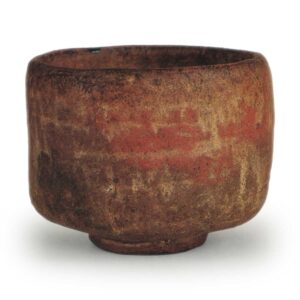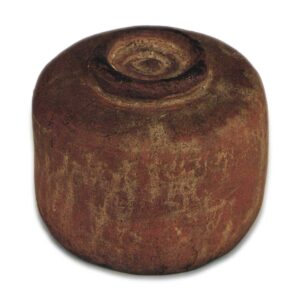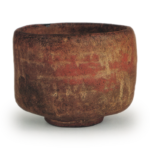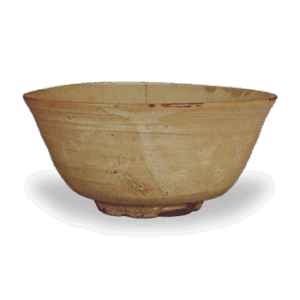

Height: 8.3cm
Diameter: 9.9-10.2cm
Outer diameter of foot: 4.8-5.1cm
Height of foot: 0.9cm
The name “Jirobo” is thought to have been given because the tea bowl is similar in style to the Tarobo tea bowl, and is thought to mean “younger brother”. Both are red Raku tea bowls, and although the workmanship is similar, they are not exactly identical. However, when I recently had the opportunity to closely examine “Tokaibo”, I measured the cross-sectional diagram and discovered that, although there are differences in the black and red, the workmanship is exactly the same.
The glaze on the “Toukabou” is thick, while the glaze on the “Jirobou” is thin, so they don’t look that similar, but it’s not an exaggeration to say that they are exactly alike.
It is a slightly small teacup, and it is made quite thickly from the body to the waist. In particular, the thickness of the waist is unexpectedly thick, so it feels heavy for its small size.
Compared to the Daikoku, the waist is stronger, the body is plump, and the mouth is held inwards as usual. The inside is tightened at the center of the body, the depth of the bowl is deeply carved out, and the center of the bowl is slightly sunken.
The foot ring is high and clearly visible, and the foot ring is shallowly hollowed out. The circle within the foot ring is clearly hollowed out, with the center of the circle being the center of the helmet cloth, and there are five marks left on the tatami mat.
The transparent glaze applied to the entire piece is strong, as with the “Muichimono”, and the reddish clay surface characteristic of Chojiro tea bowls can be felt. Furthermore, because the glaze is thin, it is interesting to be able to see the traces of the scraping process clearly, and the fact that the clay surface is not smooth makes us imagine that the glaze was applied while the piece was still in its scraped-out state.
Therefore, the white glaze remains in the deeper hollows, creating a mottled effect, but it also makes the tea bowl look even more wabi.
The foot ring also shows almost the bare clay, and the foot ring is covered in a lot of white glaze. The glaze on the inside is better than the outside, but it has become brown due to tea stains and other marks. There is a crack on the rim and a loose spot on the rim, which has been repaired with lacquer. There are also three small cracks on the rim. On the bottom of the inner box, there is a haiku poem written by Sen Sōtan, the same person who wrote the inscription on the lid, “Chōjirō tea bowl, red tea bowl”. The meaning of the kyoka poem is interpreted as “There are many tea bowls in my possession, but Jirobo is a well-made tea bowl with a high nose, even in this world”, and it is interesting that the tea bowl is referred to as “the family of tea”.
The inscription on the underside of the lid, “Jirobo Chojiro-yaki teacup, Sosai (signature),” is a signature of Sosai Zuiryusai, but the accompanying paper with the inscription “Jirobo” on the outside of the box is unsigned. It is thought that it was probably owned by Sotan, but after that it is unclear. However, according to what I have heard, it was owned by Hakusan Zengoro of the Osaka Konoike clan, and then it became a family heirloom of the Murahiko family of the old house in Kaga Kanazawa, it is also mentioned in Toda Rogen’s collection of tools and notes, “Gogaku-shu”, as “Jirobo Akabako Motohaku-doko ni Kyoka aru Hako-gai Ura Zuiryu Kanshu Murashige”.
It is not clear when it came into the possession of Murahiko, but because it was kept in the same family for a long time, it was not included in the “Taisho Meiki Kan” (A Guide to Famous Musical Instruments of the Taisho Period) along with Aoido’s “Yama no I”.








